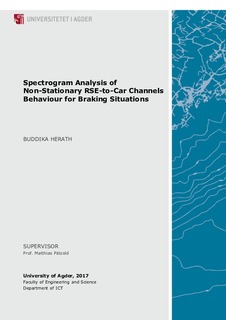| dc.description.abstract | Car-to-car (C2C) and car-to-infrastructure (C2I) communications promise revolutionary
improvements in transportation due to its possibilities to improve the road safety and
tra c management. C2C is a system designed to exchange information between vehicles,
and C2I is a communication model that allows vehicles to share information with the
infrastructure such as roadside equipment (RSE). These communications are considered
as essential elements of the intelligent transport system (ITS). In this regard, reliability
of the communication is vital to provide warning of an impending accident. Thus, the
analysis of RSE-to-car channel behaviour is important and in this research work we use
the concept of the spectrogram to estimate the local Doppler power spectral density
(PSD) of the channel.
One of the standard assumptions of mobile radio channel modelling is that the speed
of the mobile station (MS) is constant. However, in the real-world, mobile communication
channels exhibit non-stationarity as the speed varies with the time. The nonstationary
multipath fading channels can be modelled by a sum of SOCh processes. If
the speed is constant, the channel can be de ned as a stationary channel consisting a
sum of a SOCi processes.
The Spectrogram provides an estimate of the changes to local Doppler power spectral
density over time for the variations of the mobile speed. In this research work, we
de ne the spectrogram using di erent window functions and show that the spectrogram
can be split into an auto-term and a cross-term. The auto-term consists of relevant
spectral information and the cross-term is considered as a sum of spectral interferences.
Additionally, we investigate the spectrogram result optimisation by averaging over the
phases and selecting an optimal window length. Furthermore, our study shows that the
time-variant average Doppler shift, computed by taking the sum of all power-weighted
Doppler shifts normalised to the total received power of the multipath components,
is realisable by the estimated average time-variant Doppler shift computed from the
spectrogram.
When the brakes are applied at a constant speed the channel's spectral characteristics
convert from stationary to non-stationary state. We estimate the local Doppler PSD for
braking situations and show the possibility of developing this model to detect road
accidents.
keywords: auto-term, braking, cross-term, spectrogram, STFT, window function, window
length, windowing | nb_NO |

